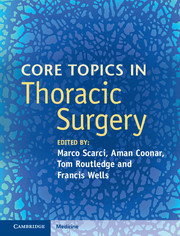Book contents
- Frontmatter
- Contents
- List of contributors
- Section I Diagnostic work-up of the thoracic surgery patient
- Section II Upper airway
- Section III Benign conditions of the lung
- Section IV Malignant conditions of the lung
- 11 Evaluation of solitary pulmonary nodule
- 12 Lung cancer staging
- 13 Pathological considerations in lung malignancy
- 14 Medical treatment of lung cancer (neo and adjuvant chemoradiotherapy)
- 15 Superior vena cava obstruction: etiology, clinical presentation and principles of treatment
- 16 Robotics in thoracic surgery
- 17 Pulmonary metastasectomy
- Section V Diseases of the pleura
- Section VI Diseases of the chest wall and diaphragm
- Section VII Disorders of the esophagus
- Section VIII Other topics
- Index
- References
12 - Lung cancer staging
from Section IV - Malignant conditions of the lung
Published online by Cambridge University Press: 05 September 2016
- Frontmatter
- Contents
- List of contributors
- Section I Diagnostic work-up of the thoracic surgery patient
- Section II Upper airway
- Section III Benign conditions of the lung
- Section IV Malignant conditions of the lung
- 11 Evaluation of solitary pulmonary nodule
- 12 Lung cancer staging
- 13 Pathological considerations in lung malignancy
- 14 Medical treatment of lung cancer (neo and adjuvant chemoradiotherapy)
- 15 Superior vena cava obstruction: etiology, clinical presentation and principles of treatment
- 16 Robotics in thoracic surgery
- 17 Pulmonary metastasectomy
- Section V Diseases of the pleura
- Section VI Diseases of the chest wall and diaphragm
- Section VII Disorders of the esophagus
- Section VIII Other topics
- Index
- References
Summary
Lung cancer is the second most common cancer in the UK and a leading cause of cancer-related deaths worldwide. Prognosis and treatment options vary depending on the pathological type and the anatomical extent of the tumour. Both over-treatment of advanced disease and under-treatment of limited disease can reduce quality and length of life. Therefore, prompt and accurate staging are important to ensure delivery of appropriate therapy.
Clinical presentation
A large proportion of primary lung cancers are asymptomatic, and poor awareness of signs and symptoms of lung cancer in the general population means that patients often present late. Clinical features identified by careful history and examination can direct tests. More recently, the increasing availability of CT screening has led to an increased detection of early cancers, and this may result in a real survival advantage by curing disease found at an early stage. Alternatively, it may just represent a lead-time bias.
Staging systems
Staging helps in advising on prognosis, planning treatment and comparing data. There are two parts, the TNM (tumour, node, metastasis) and the stage groups.
Different TNM combinations have been aggregated into stage groups that differ by their prognosis. The TNM and stage groups are based on the outcomes of many pragmatically managed patients and undergo periodic review. This means there can be differences between versions, and while these may be small, users should be aware of them.
TNM status
The TNM status describes the anatomical extent of cancer based on tumour size, location and any local invasion, lymph node involvement and metastasis. Nodal involvement is described based on lymph node stations, as described by Mountain and Dresler.
The seventh and most recent revision of the TNM staging system for lung cancer, summarized in Table 12.1, started to be used in 2010. It is based on multicentre data from more than 80,000 patients. At various stages of the diagnostic pathway, the patient's TNM status can be updated. The clinical stage (cTNM) and the pathological stage (pTNM) (post-operative) have different prognoses. It is important to note that the data set employed to determine the seventh edition of the TNM classification predated the widespread use of positron-emission tomography (PET) scanning and therefore does not fully reflect the importance of that tool, which is now a standard of care for lung cancer staging in the UK and many other places.
- Type
- Chapter
- Information
- Core Topics in Thoracic Surgery , pp. 121 - 126Publisher: Cambridge University PressPrint publication year: 2016



